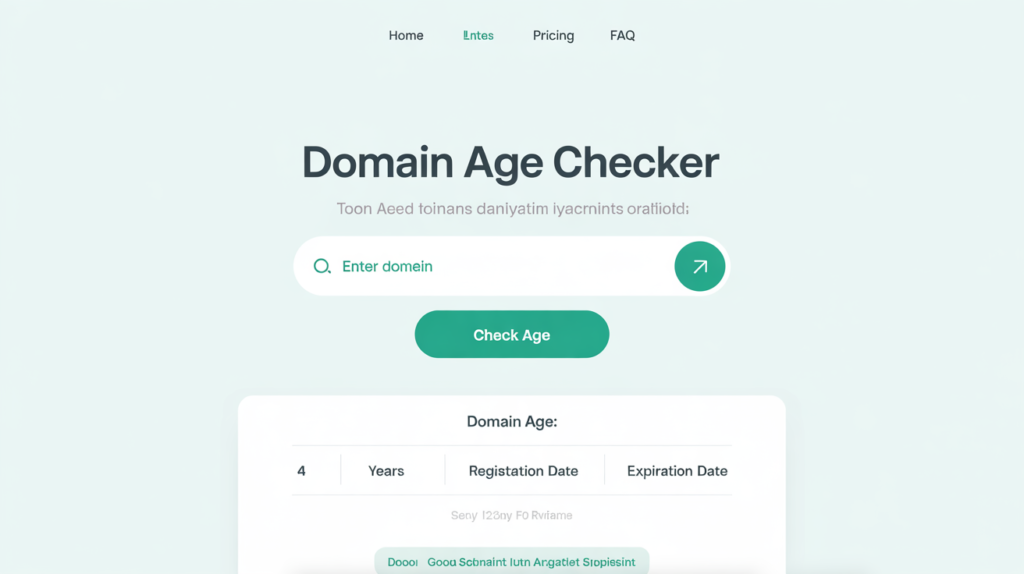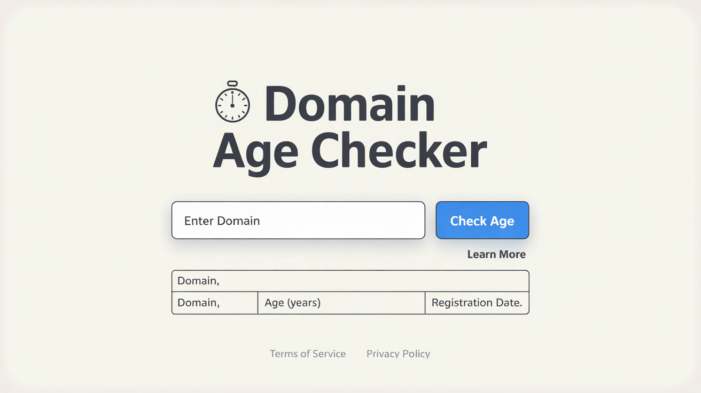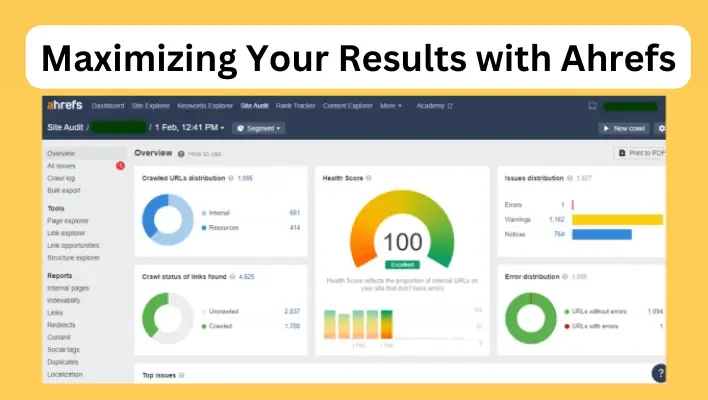How to Use a Domain Age Checker to Boost Your SEO Strategy
Are you ready to unlock the secrets of your website’s success? In the ever-evolving world of search engine optimization, understanding every facet of your site can make all the difference. One often-overlooked yet powerful tool in an SEO strategist’s arsenal is a domain age checker. But why does domain age matter, and how can it elevate your SEO game? Whether you’re a seasoned digital marketer or just starting out on your online journey, this blog post will guide you through the ins and outs of using a domain age checker effectively. Get ready to discover how leveraging this simple tool can give you insights into competition, enhance trustworthiness with search engines, and ultimately drive more organic traffic to your site. Let’s dive in!
Contents
Introduction to Domain Age Checker

In the fast-paced world of digital marketing, every detail counts. One often overlooked aspect is domain age. While many focus solely on keywords and backlinks, understanding how long a domain has been active can provide valuable insights into your SEO strategy. Enter the Domain Age Checker—a powerful tool that reveals more than just numerical data about a website’s lifespan.
Imagine having access to information that helps you gauge authority and trustworthiness in your niche. This is where tools like Mini SEO Tools come into play, offering a straightforward way to analyze domain age and propel your site’s SEO efforts forward. Whether you’re an experienced marketer or just starting out, grasping the importance of domain age could give you an edge over the competition. Ready to dive deeper? Let’s explore how you can use this tool effectively!
Why is Domain Age Important for SEO?
Domain age plays a crucial role in search engine optimization. Older domains often convey authority and trustworthiness to search engines like Google.
When a website has been around for several years, it typically accumulates valuable backlinks and traffic over time. This history can boost its rankings significantly compared to newer sites.
Additionally, established domains have usually undergone various updates, which indicates active management. Regular changes signal to search engines that the site is relevant and up-to-date, enhancing its credibility.
Many users also prefer clicking on older domains due to perceived reliability. A well-established site can attract more organic traffic simply because of its age factor.
Lastly, domain age can influence competition levels within your niche. Understanding how long competitors have been operating helps shape your strategy for growth and visibility in the digital landscape.
How to Use a Domain Age Checker
To start using a domain age checker, first choose a reliable tool. Mini SEO Tools offers an easy-to-navigate interface that provides accurate results.
Next, enter the website URL you want to investigate. This could be your own site or one of your competitors. Make sure to double-check for any typos to ensure accuracy.
Once you’ve submitted the URL, analyze the results presented by the tool. Look for key metrics such as domain registration date and last update information. These insights will help you understand how long the website has been active and its SEO potential.
Pay attention to additional data like expiration dates too; this can indicate whether a site might soon change hands or become inactive. Understanding these details can significantly inform your SEO strategies moving forward.
Step 1: Choose a Reliable Domain Age Checker Tool
Choosing the right domain age checker tool is crucial for gathering accurate data. Not all tools are created equal, and some may provide misleading information.
Look for a reputable source that has positive user reviews. Mini SEO Tools is a solid choice; it’s known for its reliability and straightforward interface. You want something that offers comprehensive results without confusing jargon.
Check if the tool provides additional insights beyond just age—like registration and expiration dates. This added context can be invaluable in your SEO strategy.
Ensure the website operates smoothly on both desktop and mobile devices. Accessibility matters when you’re on-the-go or need quick checks during meetings.
A trustworthy domain age checker will empower you with data to inform your decisions effectively, setting a strong foundation for analyzing competitors or enhancing your own site’s authority.
Step 2: Enter Your Desired Website URL
Now that you’ve chosen your domain age checker tool, it’s time to enter the website URL you want to analyze. This is a straightforward step but crucial for gathering accurate data.
Make sure to input the full URL, including “http://” or “https://.” A small error in spelling can lead to inaccurate results.
Once you’ve typed it in, double-check before hitting enter. It’s easy to overlook details when you’re eager for insights.
After entering the URL, click on the search button and let the magic happen. The tool will pull up valuable information about the domain’s age and other important metrics within moments.
This process sets the stage for understanding how long that site has been around and its potential authority in search engine rankings.
Step 3: Analyze the Results
Once you’ve entered the URL into your chosen domain age checker, it’s time to analyze the results. Pay attention to key metrics that can reveal a lot about the website’s history.
First, take note of the domain registration date. A longer registration period often signifies trustworthiness in Google’s eyes. If a site has been around for several years, it likely has built up some authority.
Next, look at any changes in ownership or updates. Frequent shifts can indicate instability and may impact SEO rankings negatively.
Finally, examine additional details like expiration dates. If a domain is close to expiring but still ranks well, it might be worth investigating its backlinks and content strategy further.
Understanding these components will help shape your approach as you craft an effective SEO strategy tailored to market dynamics.
Interpreting the Results of a Domain Age Checker
When you get results from a domain age checker, there’s more to it than just the number of years a website has been active. The registration date, last update, and expiration date tell different stories.
The registration date indicates how long the site has existed. A longer-established domain suggests credibility and trustworthiness in the eyes of search engines.
Next, pay attention to the last update. Frequent updates often signal that a site is maintained actively, which can positively influence its SEO performance.
Lastly, take note of the expiration date. If a domain is nearing its expiry without renewal, it might mean potential instability for users and search engines alike.
Understanding these nuances can help refine your SEO strategy significantly when engaging with established domains or evaluating competitor sites.
Understanding the Importance of Domain Registration Date, Last Update, and Expiration Date
The domain registration date is crucial for assessing a website’s credibility. Older domains are often seen as more trustworthy by search engines and users alike. A well-established domain can signal authority in your niche.
Equally important is the last update date. It reflects how frequently a site is maintained or revamped. Regular updates indicate active management, which can positively influence SEO rankings. Search engines favor fresh content that keeps pace with changing trends.
Then there’s the expiration date, revealing how long the owner intends to keep control over it. If a domain has an impending expiration without renewal, it could signify instability or abandonment to visitors and search engines.
Understanding these dates helps you make informed decisions about your own web presence and competitor analysis. They play vital roles in shaping strategies around backlinking opportunities and overall digital marketing efforts.
How to Determine if a Website has Changed Ownership and its Impact on SEO
Detecting ownership changes of a website can significantly influence your SEO strategy. When a site transitions to new management, it may alter its content approach, backlinks, and overall authority.
A reliable domain age checker tool can provide insights into the registration history. If you notice frequent updates in ownership data, this might indicate instability that could affect search rankings.
Additionally, evaluate the site’s backlink profile. A shift in ownership often leads to changes in link quality and relevance. New owners may discard old links or pursue different partnerships.
Always check for historical data on web archives like Wayback Machine too. Understanding past content can reveal how previous strategies fared and what current owners might be doing differently.
These factors combined give clarity on how ownership affects credibility and visibility in search engines. Such analysis is crucial for making informed decisions about potential collaborations or competition monitoring.
Tips for Boosting Your SEO Strategy with a Domain Age Checker
Utilizing a domain age checker can significantly enhance your SEO strategy. Start by analyzing historical data. Look for trends over time, such as content updates and traffic spikes. This information can inform your own content schedule.
Next, consider established websites with older domains. These sites often have built credibility and authority in their niche. Use the domain age checker to identify potential backlink opportunities from these trusted sources.
Engage with these sites through guest posts or collaborations. Building relationships here can lead to valuable backlinks that improve your rankings.
Don’t overlook competitors either. Assess their domain ages alongside yours to gauge market presence and trustworthiness within your field.
By leveraging insights gained from a reliable tool like Mini SEO Tools‘ Domain Age Checker, you can adapt strategies effectively, ensuring you’re always one step ahead in the SEO game.
Utilizing Historical Data to Improve Rankings on Search Engines
Harnessing historical data can be a game-changer for your SEO efforts. By analyzing the age of a domain, you gain insights into its history and authority. Older domains often come with established trust and credibility in search engines.
You can track how changes over time have affected rankings. If an older site experienced a drop, understanding why could provide valuable lessons for your own strategy. Maybe they changed content or neglected backlinks; knowing this helps you avoid similar pitfalls.
Moreover, examining trends in keyword performance over time gives context to seasonal fluctuations or algorithm updates. This knowledge allows you to adapt your content strategy proactively rather than reactively.
Leveraging these insights from domain age not only boosts your current approach but also builds a foundation for future growth on search engines like Google. Embracing the past is key to paving the way forward effectively.
Identifying Potential Backlink Opportunities from Established Websites
To maximize your SEO strategy, leveraging a domain age checker can open up valuable opportunities. One of the key benefits is identifying potential backlink opportunities from established websites.
When you analyze older domains, look for those that have consistently provided high-quality content and maintained their authority over time. Such sites are often more trusted by search engines, making backlinks from them highly beneficial for your own site’s credibility and ranking.
Reach out to these established websites with relevant content or collaborations. Highlight how linking to your website will provide value to their audience as well. Building relationships with seasoned webmasters can lead to organic backlinks that enhance your visibility on search engine results pages.
Using tools like Mini SEO Tools‘ Domain Age Checker not only allows you to gather essential data about a domain’s history but also guides you in crafting an effective backlink strategy that leverages the experience and trustworthiness of older sites in your niche.
By integrating this approach into your overall SEO tactics, you’ll be better positioned to climb the rankings while fostering connections within the industry.
Conclusion
As you can see, using a domain age checker can greatly benefit your SEO strategy and help improve your website’s search engine ranking. By regularly checking the age of your domain, you can stay ahead of any potential issues and make adjustments to maintain or increase its authority. Don’t overlook the importance of domain age in SEO – give it some attention and watch as your website climbs higher in search results. With these tips, you’re well on your way to boosting your online presence with a strong and established domain!



















